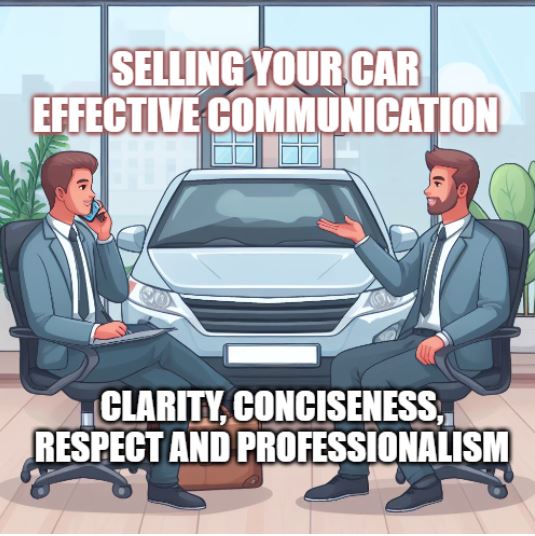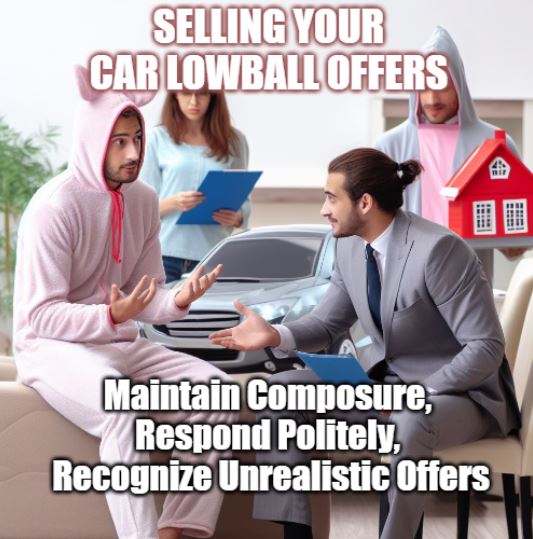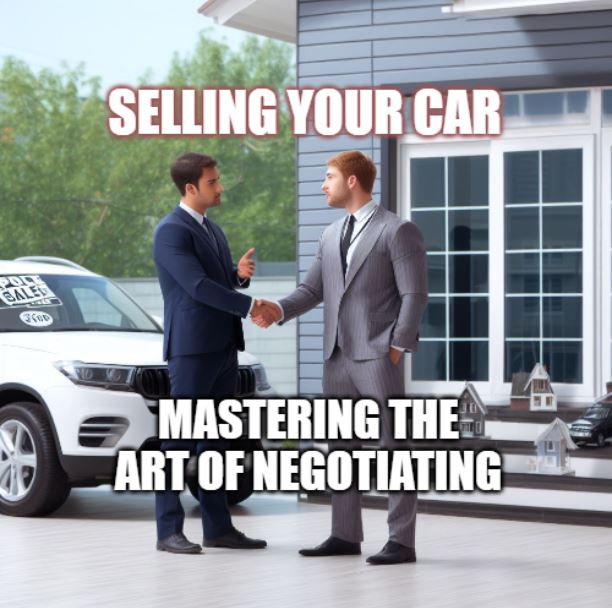Are you ready to sell your car? Perhaps you’ve decided it’s time to part ways with your trusty vehicle, and you’re eager to make the sale. Selling your car is not just about putting up a “For Sale” sign and waiting for offers to roll in.
To get the best value for your vehicle, you need to master the art of negotiating with potential buyers. In this comprehensive guide, we’ll walk you through the entire process of selling your car, with a special focus on effective negotiation strategies. From setting the right price to closing the deal, we’ve got you covered.

Setting the Right Price
When you decide to sell your car, the first crucial step is setting the right price. You want to attract potential buyers without underselling your vehicle.
Setting the right price for your car is a critical step in attracting potential buyers and achieving a successful sale. Here are key strategies for setting the right price, presented in bullet points for clarity:
- Market Research:
- Conduct thorough market research to understand the current pricing trends for similar vehicles in your area.
- Examine various sources, such as online listings, classified ads, and dealership prices, to gauge the competitive landscape.
- Know Your Car’s Value:
- Understand your car’s value by considering various factors, including make, model, year, mileage, condition, and any unique features or upgrades.
- Utilize online tools and resources designed for car valuation to get an accurate estimate.
- Pricing Strategy:
- Develop a pricing strategy that balances competitiveness with profitability.
- Aim for a price that appeals to potential buyers without significantly undervaluing your car.
- Avoid Overpricing:
- Be cautious about overpricing, as it may deter potential buyers and extend the time your car sits on the market.
- Pricing too high can make your car less competitive and lead to unnecessary price reductions later.
- Competitive Yet Reasonable:
- Set a competitive yet reasonable price based on your research and the condition of your car.
- Consider your car’s unique selling points and any recent maintenance or upgrades that can justify a slightly higher price.
- Incorporate Negotiation Room:
- Keep in mind that most buyers expect some negotiation.
- Price your car slightly higher than your minimum acceptable amount to leave room for bargaining.
The Art of Negotiation
When you meet with potential buyers, the negotiation phase begins. This is where you’ll use your skills to secure the best deal.
Mastering the art of negotiation when selling your car involves several key principles and strategies. Here, we break down the crucial aspects of negotiation using bullet points for a clear and concise understanding:
- Confidence:
- Approach negotiations with unwavering confidence in the value of your car.
- Confidence can instill trust in potential buyers and influence their perception of your car’s worth.
- Preparation:
- Research your car’s market value, considering make, model, year, mileage, and condition.
- Determine a competitive yet reasonable asking price to guide negotiations.
- Gather all necessary documents, such as the car title and maintenance records, in advance.
- Openness to Compromise:
- Understand that negotiations often require compromise.
- Be prepared to make reasonable concessions while staying within your desired price range.
- Effective Communication:
- Use clear and concise language to convey your points and intentions.
- Listen actively to the buyer’s questions and concerns.
- Maintain a polite and respectful tone throughout the negotiation.
- Handling Lowball Offers:
- Respond to lowball offers with professionalism and politeness.
- Politely counter the offer, explaining the rationale for your asking price and emphasizing the car’s value.
- Be open to constructive negotiation while keeping your bottom line in mind.
- Win-Win Approach:
- Aim for a win-win outcome in negotiations by finding common ground.
- Understand the buyer’s needs and expectations and work towards satisfying them while maintaining your desired price.
- Setting a Bottom Line:
- Define your bottom line, the lowest acceptable price for your car, before negotiations begin.
- This benchmark helps you navigate negotiations and decide when to walk away from unworkable offers.
- Negotiation Dynamics:
- Recognize that negotiation is a dynamic process that can evolve over time.
- Be flexible and adaptable in response to changing circumstances and buyer concerns.
- Non-Verbal Communication:
- Pay attention to non-verbal cues, such as body language and tone of voice.
- Maintain a confident and approachable demeanor during negotiations.
- Patience and Persistence:
- Understand that negotiations may take time, and not all potential buyers will make immediate decisions.
- Stay patient and persistent in your efforts to secure the best deal.
- Documentation:
- Keep all necessary paperwork ready for a smooth transition of ownership.
- This includes the car title, maintenance records, and a bill of sale.
- Final Inspection:
- Conduct a final inspection with the buyer before completing the sale.
- Ensure both parties agree on the car’s condition at the time of the transaction.
- Mutual Respect:
- Maintain professionalism and show respect to the buyer, regardless of the negotiation’s progress.
- A respectful and courteous attitude can foster a positive atmosphere for the deal.

Effective Communication
Clear and concise communication is essential. Ensure that both you and the buyer understand the terms and conditions of the sale. Ambiguity can lead to misunderstandings and conflicts.
Effective communication during the process of selling your car is essential for building trust, understanding, and successful negotiations. Here, we break down the components of effective communication using bullet points for clarity:
- Clarity and Conciseness:
- Use clear and concise language to convey your points and intentions.
- Avoid jargon or overly technical terms that may confuse potential buyers.
- Active Listening:
- Actively listen to the buyer’s questions, concerns, and preferences.
- Show that you value their input and are willing to address their needs.
- Respect and Professionalism:
- Maintain professionalism throughout the negotiation process.
- Be polite, courteous, and respectful, regardless of how the negotiation unfolds.
- Non-Verbal Communication:
- Pay attention to non-verbal cues, such as body language, facial expressions, and tone of voice.
- Maintain a confident and friendly posture, making eye contact to create a comfortable and trustworthy environment.
- Written Communication:
- Craft written messages with proper grammar, spelling, and clarity.
- Respond to emails, texts, or online inquiries in a timely and well-structured manner.
- High-quality photos and a well-organized online listing also play a vital role in conveying information effectively.
- Flexibility and Adaptability:
- Be flexible in adapting your communication style to the buyer’s preferences.
- Recognize that every buyer is unique and may have varying communication styles.
- Show adaptability by accommodating specific questions or requests as needed.
- Transparency:
- Be honest and transparent about your car’s condition, including any imperfections.
- Honesty builds trust with buyers, making the negotiation process smoother.
- Setting Expectations:
- Set clear expectations regarding the negotiation process, pricing, and documentation.
- This helps both you and the buyer understand the terms and conditions of the sale.
- Clarity in Documentation:
- Ensure that all paperwork, including the car title and maintenance records, is organized and easily accessible.
- Provide complete and accurate information to the buyer to build trust.
- Timely Responses:
- Respond to buyer inquiries promptly to keep potential buyers engaged and interested.
- Delayed responses can lead buyers to consider other options.
- Openness to Questions:
- Encourage potential buyers to ask questions and express their concerns.
- Be willing to provide thorough and clear answers to address any doubts they may have.
Effective communication is not just a tool; it’s the cornerstone of trust, understanding, and successful negotiation. By mastering these communication elements, you can build a strong foundation for productive interactions with potential buyers and increase your chances of securing the best deal when selling your car.

Handling Lowball Offers
If you receive a lowball offer, respond politely and explain your pricing rationale. Keep the conversation positive and open the door for counteroffers.
Dealing with lowball offers during the negotiation process can be a challenging yet essential aspect of selling your car. Here are the key strategies for effectively handling lowball offers, presented in bullet points for clarity:
- Maintain Composure:
- Remain composed and professional when confronted with a lowball offer.
- Emotional reactions can set the tone for the negotiation; stay calm and collected.
- Polite Response:
- Respond to lowball offers with politeness and courtesy.
- Acknowledge the buyer’s interest and express your appreciation for their offer.
- Rationale for Asking Price:
- Politely counter the offer by explaining the rationale behind your asking price.
- Emphasize the value of your car, considering its features, condition, and maintenance history.
- Constructive Negotiation:
- Engage in constructive dialogue with the buyer, focusing on finding common ground.
- Encourage the buyer to express their concerns or expectations and be open to addressing them.
- Win-Win Approach:
- Strive for a win-win outcome by understanding the buyer’s needs and working towards a mutually satisfactory agreement.
- Balance your desired price with the buyer’s budget to create a beneficial deal for both parties.
- Setting a Bottom Line:
- Establish your bottom line, which is the lowest acceptable price for your car, before negotiations commence.
- This benchmark helps guide your negotiation and enables you to decide when it’s necessary to walk away from unreasonable offers.
- Negotiation Dynamics:
- Understand that negotiation is a dynamic process that can evolve over time.
- Be flexible and adaptable in response to changing circumstances and buyer concerns.
- Recognize Unrealistic Offers:
- Be able to differentiate between lowball offers that can be negotiated and those that are unrealistic.
- Evaluate whether the buyer’s expectations are within a reasonable range of your asking price.
- Leave Room for Negotiation:
- When countering a lowball offer, allow room for negotiation by being open to reasonable compromises.
- Finding a middle ground is often the key to reaching a successful agreement.
- Know When to Walk Away:
- Recognize when the buyer’s expectations are too far from your asking price, and negotiations are unlikely to proceed.
- Be prepared to walk away amicably if an agreement cannot be reached.
Handling lowball offers requires a combination of professionalism, effective communication, and a willingness to find common ground. By responding with politeness, providing a rationale for your asking price, and being open to constructive negotiation, you can increase the chances of transforming a lowball offer into a successful sale. Remember that negotiation is a collaborative process aimed at satisfying both parties, and with the right approach, you can find a mutually beneficial agreement.
Successfully selling your car involves various stages, from setting the right price to effective negotiation and finalizing the deal. By following these steps and tips, you can navigate the process with confidence and secure the best possible outcome. Don’t hesitate to use phrases like “sale my car” and “sell my car online” in your advertising to attract potential buyers. Now that you’re armed with this knowledge, it’s time to make the sale. Happy selling!
If you’re interested in a hassle-free car sale, SellMyCarColorado is here to provide you with a reasonable offer.
